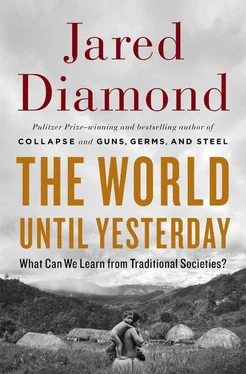Rights to use land and resources, whether exclusively or non-exclusively, imply the concept of ownership. Who owns the n!ore of a !Kung band? The answer is: the band’s k’ausi, meaning a core group of older people or else one older person descended from the people who have lived in that area for the longest time. But band composition is fluid and changes from day to day, because people often go visit relatives in other n!ores, people make seasonal visits to other n!ores for waterholes or for superabundant food, some people shift bands permanently for various reasons, and a new bridegroom plus his dependents (his old parents, and his first wife and children if he is now taking a second wife) may live with his new wife’s band for about a decade until he and his new wife have given birth to several children. As a result, many !Kung spend more time outside than inside their n!ore. In an average year 13% of the population shifts residence permanently from one camp to another, and 35% of the population is dividing its residential time equally between two or three camps. Under those circumstances the band in the neighboring n!ore consists partly of your own people; they’re not evil subhumans with whom the only inter-group transfers are just two intermarriages over the course of several generations, as in the case of my New Guinea mountain friends. You’re not going to take a hard-line exclusive approach to your resources when many of the “intruders” are actually your siblings and cousins, your adult children, and your aged parents.
Another interesting illustration of non-exclusive territories involves North America’s Great Basin Shoshone, Native Americans belonging to the same language group as the Owens Valley Shoshone whom I already mentioned as illustrating exclusive territories. Their Great Basin cousins differed in land use because of differences between the environments. Whereas Owens Valley land was well watered, suitable for irrigation, and worth defending, the Great Basin is a harsh dry desert, very cold in the winter, with sparse and unpredictable resources and little opportunity for food storage. Human population densities in the Great Basin were only about one person every 16 square miles. The Great Basin Shoshone lived in separate families for much of the year, aggregating in the winter into camps of 5 or 10 families near springs and pine nut groves, and infrequently aggregating into larger groups of up to 15 families for communal hunts of antelopes and rabbits. They did not maintain well-marked territories. Instead, individual families owned specific sites such as pine groves, which could be shared with other families but only by agreement: trespassers who attempted to harvest pine nuts without an agreement were driven off by a barrage of stones. Other plant and animal resources were shared under flexible non-exclusive rights.
Finally, a minimum in recognizing and patrolling territories was achieved by Peru’s Machiguenga Indians and Bolivia’s Siriono Indians in tropical forested areas. At the times that those groups were studied by anthropologists, the Machiguenga were gardeners living at only modest population densities, possibly because a previously denser population had crashed from effects of European-introduced diseases or else killings during the rubber boom, and also because agriculture in their area offered only low yields. The Machiguenga undertook seasonal movements for wild foods and cleared slash-and-burn gardens that produced food for just a few years and weren’t worth fighting over. There were no territories: in theory all resources of all forests and rivers were open to all Machiguengas. In practice, multi-family groups maintained some distance from each other’s home ranges. Similarly, the Siriono Indians studied by Allan Holmberg lived by hunting-gathering and some casual agriculture in bands of 60 to 80 people possessing no defined territories. But if one band came across hunting tracks made by another band, it chose not to hunt in that other band’s area. That is, there was informal mutual avoidance.
Thus, traditional land use ranged over a spectrum, from well-marked territories that were patrolled and defended and from which outsiders were excluded on pain of death, through fuzzy home ranges without clear boundaries and which outsiders could use by mutual agreement, to home areas kept separate just by informal mutual avoidance. No traditional society tolerated the relatively open access enjoyed by modern Americans or European Union citizens, most of whom can travel anywhere within the U.S. or European Union and can travel in many other countries as well merely by presenting a valid passport and visa to a border passport control officer. (Of course the September 11, 2001, World Trade Center attack has pushed Americans back towards a traditional suspicion of strangers and has resulted in restrictions on free travel, such as no-fly lists and airport security checks.) But one could also argue that our modern system of relatively open access is an upscale extension of traditional access rights and restrictions. Traditional peoples, living in societies of a few hundred individuals, obtain access to others’ lands by being known individually, by having individual relationships there, and by asking permission individually. In our societies of hundreds of millions, our definition of “relationship” is extended to any citizen of our state or of a friendly state, and the asking of permission is formalized and granted en masse by means of passports and visas.
Friends, enemies, and strangers
All those restrictions on free movement cause members of small-scale societies to divide people into three categories: friends, enemies, and strangers. “Friends” are the members of your own band or village, and of those neighboring bands and villages with which your band happens to be on peaceful terms at the moment. “Enemies” are members of neighboring bands and villages with which your band happens to be on hostile terms at the moment. Nevertheless, you probably know at least the names and relationships, and possibly the appearances, of many or most individuals in those hostile bands, because you’ll have heard of them or actually met them in the course of negotiations for compensation, periods of peace resulting from shifting alliances, and exchanges of brides (or occasionally grooms) during those truces. An example is those two river men who had married into the village of my mountain friends.
The remaining category is “strangers”: unknown individuals belonging to distant bands with which your band has little or no contact. Rarely or never do members of small-scale societies encounter strangers, because it’s suicidal to travel into an unfamiliar area to whose inhabitants you are unknown and completely unrelated. If you do happen to encounter a stranger in your territory, you have to presume that the person is dangerous, because (given the dangers of traveling to unfamiliar areas) the stranger is really likely to be scouting in order to raid or kill your group, or else trespassing in order to hunt or steal resources or kidnap a marriageable woman.
In a small-scale local population numbering several hundred people, you’ll certainly know all members by name and face, the details of all their relationships by blood and marriage and adoption, and how they are related to you. When you add to your own band the several neighboring friendly bands, your potential universe of “friends” may number over a thousand people, including many whom you’ve heard of but never actually seen. Hence suppose that, while out alone away from your core area or near the boundary of your territory, you meet a person or people whom you don’t recognize. If there are several of them and just one of you, you’ll run away, and vice versa. If there is one of you and one of them, and if the two of you see each other at a distance, both of you may run away if a glance suggests a balance of strength (e.g., two adult men, rather than a man confronting a woman or a child). But if you come around a corner and suddenly confront another person unexpectedly, and it’s too late to run away, that’s a recipe for a tense situation. It can be resolved by the two of you sitting down, each of you naming yourself and your relatives and exactly how you are related to them, and continuing in an effort to identify a relative in common, such that the two of you would have some relationship to each other and wouldn’t have grounds to attack each other. But if after several hours of such a conversation the two of you still can’t identify any relative in common, then you can’t just turn around and say, “It was nice to meet you, goodbye.” Instead, you or he or both of you must consider the other a trespasser without a relationship justifying a visit, and a chasing-off or a fight becomes likely.
Читать дальше










